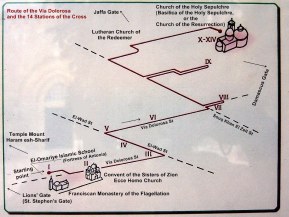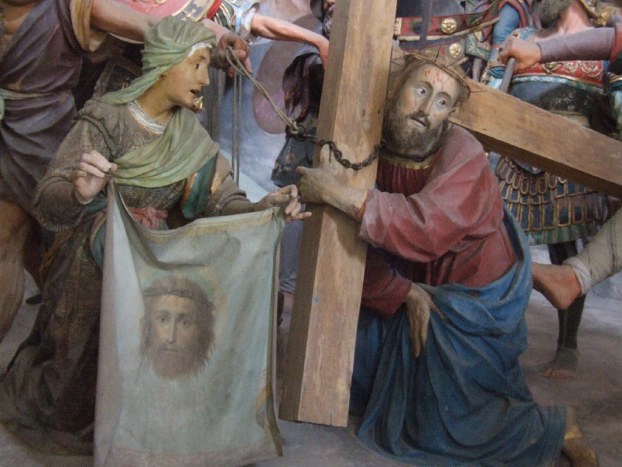14 Stations of the Cross (of Jesus Christ)
The Way of the Cross - Via Crucis or Via Dolorosa (Sorrowful Way, Way of Grief, Way of Sorrows,Way of Suffering or Painful Way),
is a road between the fortress Antonia and Golgotha, along which Christ walked with the Cross.
The present route begins near Lions Gate (St. Stephen's Gate), in the Muslim Quarter, and ends within the Church of the Holy Sepulcher, in the heart of
the Christian Quarter. This route is marked by 14 Stations of the Cross - 9 stations along the route and 5 inside the Church of the Holy Sepulchre.
Definition — The Stations of the Cross are a series of pictures or figures showing scenes of the Passion of our Divine Saviour.
The Way of the Cross is the devout procession from the Station to another with prayer and meditation.
Object — The purpose of the Stations is to help us meditate upon the sufferings and death of our Lord, the boundless love of
God which gave to men such a Redeemer, and the malice of sin.
History — The Stations have their origin in the practice of the early Christians of Jerusalem, especially pilgrims, of visiting the places
made sacred by the presence of Jesus. St. Jerome (fourth century) tells us this was the practice in his time.
Naturally they would seek the places hallowed by His Sacred Blood and the remembrance of the Gospel lessons about His Passion and Death
would move them to prayer and sorrow for sin.
Number — The number of the Stations is fourteen. This has been fixed by tradition. Not all the incidents of the Sorrowful Way
are found in the Gospel, but we can safely follow the tradition handed down among the Christians of the Holy Land, for these,
even under Moslem oppression, were never entirely extinct. A handful of Christians would suffice to preserve the memory of the spots
sanctified by the Sacred Blood of the Saviour of mankind.
In Jerusalem — Pilgrims to this day make the Way of the Cross in the Holy City, treading their way about narrow and intricate streets
with the aid of a guide.
The Way of the Cross begins at Pilate's house and ends within the Church of the Holy Sepulchre. In this church are found the
place of the Sepulchre and that of Calvary.
Reproduction — In the course of time the Way of the Cross was reproduced in all parts of the world, usually by means of
pictures or sculptured figures representing the different scenes of the Stations and placed in churches, in convent gardens,
and other places of piety. Sometimes a cross alone stands for each Station.
Prayers — No particular form of prayer is necessary to follow devoutly the Way of the Cross and gain the Plenary Indulgence attached
to this devotion. It is required, however, that there be a devout contemplation of the scene enacted in each Station
and a prayer, usually a prayer of contrition.
There should also be a prayer at the end of the Way for the intention of the Holy Father. It is necessary to be in a state of grace in order to
gain the indulgence and the other graces of this pious act. The beautiful hymn 'Stabat Mater' is usually sung when the Way of the Cross is made publicly.
Blessing — The formal erection and blessing of the Stations through the world are entrusted to the Franciscan Fathers, who
have, since the fourteenth century, so zealously guarded the sacred places of the Holy Land. The Freeman,s Journal. March14, 1029.

The 14 Stations

Via Dolorosa "Via Crucis"
The traditional account of the 14 Stations of the Cross
Jesus is condemned to death (Trial and condemnation) (Station 1)
Jesus carries his cross (Station 2)
Jesus falls the first time (Station 3)
Jesus meets his mother (Station 4)
Simon of Cyrene helps Jesus carry the cross (Station 5)
Veronica wipes the face of Jesus (Station 6)
Jesus falls the second time (Station 7)
Jesus meets the women of Jerusalem (Station 8)
Jesus falls the third time (Station 9)
Jesus is stripped of his garments (Station 10)
Crucifixion: Jesus is nailed to the cross (Station 11)
Jesus dies on the cross (Station 12)
Jesus is taken down from the cross (Station 13)
Jesus is laid in the tomb. (Station 14)
The Scriptural Way of the 14 Stations of the Cross
To provide a version of this devotion more closely aligned with the biblical accounts, Pope John Paul II introduced a new
form of devotion, called the Scriptural Way of the Cross on Good Friday 1991. In 2007, Pope Benedict XVI approved this set of stations
for meditation and public celebration.
Jesus in the Garden of Gethsemane (prayed on the Mount of Olives)
Jesus is betrayed by Judas and arrested
Jesus is condemned by the Sanhedrin
Jesus is denied by Peter
Jesus is judged by Pontius Pilate
Jesus is scourged and crowned with thorns
Jesus takes up his cross
Jesus is helped by Simon to carry his cross
Jesus meets the women of Jerusalem
Jesus is crucified
Jesus promises his kingdom to the repentant thief
Jesus entrusts Mary and John to each other
Jesus dies on the cross
Jesus is laid in the tomb
Source. Wikipedia.
The Veil of Veronica

The legend recounts that Saint Veronica from Jerusalem encountered Jesus along the Via Dolorosa on the way to
Calvary. When she paused to wipe the blood and sweat (Latin sudor) off his face with her veil, his image was imprinted
on the cloth.
The Divine Redeemer slowly ascends the hill. Sweat streams from His Sacred Brow, and blood mingles with the sweat. Again
and again He stumbles; more than once He falls, to be roughly pulled up and goaded on by brutal soldiers. Suddenly a woman
pushes her way through a noisy crowd. In one hand she holds a cloth soaked in cold water; with the other hand she pushes this
one and that one aside till she reaches the Victim, the Lamb being led to slaughter. Falling on her knees at His Feet, she offers
Him the only assistance in her power. And the Master, His Face covered with a layer of dust caked with blood and tears, gently
accepts the cloth; He wipes His Face, and then returns the veil or towel to her, rewarding her for her loving pity by a glance of
infinite love.
The soldiers once more goad Him onward, and Veronica slips back into the crowd. She has risked her life to serve
her Lord; and her reward is not lacking. Two treasures she bears with her, and will possess until her dying day. One is the cloth
she offered the Master, which now bears the Holy Face imprinted upon it; the livid brow, the closed eyelids, the bruised cheeks,
the swollen lips, all are there. The other treasure Veronica bears in her heart; it. is the remembrance of the look of love He gave
her. Catholic Freeman's Journal. April 16, 1936
VERONICA'S HOLY VEIL
Sacred and Venerated Relic in Church. DEVOTION TO THE HOLY FACE FOSTERED IN ROME.
One of the oldest and most beautiful devotions in the Church is that of the Holy Face of Our Lord. This devotion originated on
Mount Calvary when St. Veronica wiped the face of Jesus with the veil that ever afterwards bore the imprint of his Divine features.
This chief incident connected with Veronica's veil is well known, but few people realise that the veneration of the Veil has brought
about a world-wide devotion to the Holy Face and that many miracles have been attributed to it. When His Holiness Pope Clement
governed the Church from A.D. 93 to A.D. 192, the Sacred Veil was received by him and transmitted to his successors,
who succeeded in concealing it from the enemies of Christianity during the period of persecution.
Placed in Oratory
It is not. known where the Veil was found after peace was restored to the Church. Some writers claim that it was in the Vatican Basilica
which was built by Constantine the Great, while others say that it was discovered in the Church of St. Mary of Martyrs.
In the year 707, according to the best authorities, Pope John VII built an oratory in honor of the "Blessed Virgin of the Crib" and
erected therein an altar to the Sacred Effigy of Jesus Christ. In this altar was placed the Veil, and the chapel itself was named
St. Mary's of the Sacred Face.
According to an ancient chronicle, the Holy Veil was once transported to the Hospital of the
Holy Ghost, where it was placed in a small marble and iron oratory and securely locked by six keys, which were then placed
in the care of six noble Roman families. It was publicly exposed once a year.
Procession Introduced
When the Sovereign Pontiff, Pope Innocent III, reigned, he issued a Bull in the year 1208, wherein it was ordered that the
Sacred Veil was to be carried in a religious procession from the Vatican Basilica to the Church of the Holy Ghost. This procession
took place on the first Sunday after the octave of the Epiphany, and was attended by abundant almsgiving and the alleviation of
the sufferings of the poor.
After remaining a while in the Church of the Holy Ghost the Holy Face Veil was reconveyed to
the Vatican Basilica. Many times, when war and strife was rampant in Rome, the Sacred Effigy was removed for safety to the
Castle of St. Angelo. In a journal of 1410 we read: "On the 4th of October the 'Sudarium' of St. Veronica was conveyed from the
sacristy of St. Peter's to the Castle of St.Angelo, for fear of its being exposed, in the former place, to the insults of the soldiery."
Miraculous Happening
We realise, therefore, that the Holy Veil survived the troublesome times of persecution, but not without the struggles and perils
of those who cherished it. To bring this miraculous relic up to more recent times, we come to the days of Pope Pius IX. It was
during the exile, of the Holy Father at Goeta, in 1849, that the Sacred Effigy was allowed to be exposed from Christmas to Epiphany.
On the third day of the exposition, accordingly to the story, the Divine Features of Our Lord appeared life-like and surrounded by a mild halo.
The Veil was covered by a piece of silk, that was not transparent, yet the Sacred Features were distinctly visible through it.
The Canons who were guarding the Veil immediately notified the ecclesiastics of the Basilica. The
bells were rung and the marvellous news spread throughout the city rapidly. The miracle lasted three hours and was attested
to by an apostolic notary. Since that time many copies of the Veil, have been applied to the True Relic and sent to various parts
of the world.
The present-day devotion to the Holy Face probably received its popularity.in France. But from the time of St.Clement up to
the present day, the Sovereign Pontiffs have guarded the precious Relic carefully and have surrounded it with
every mark of veneration. Many copies of the Sacred Effigies have found their way into the homes of pious Catholics throughout the world.
The Freeman's Journal. 15 March 1928